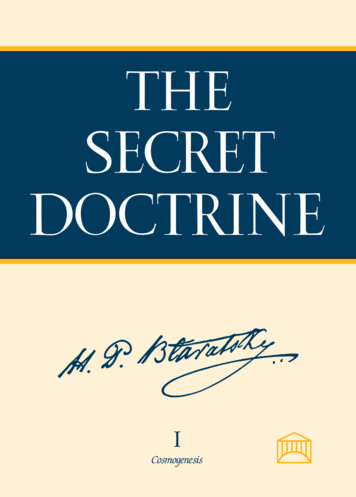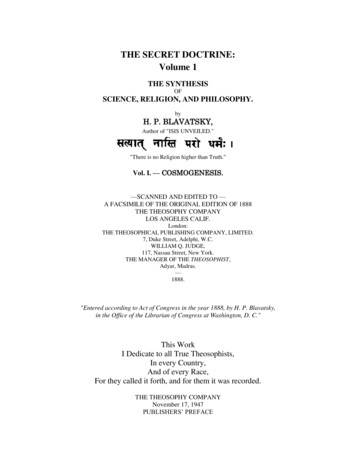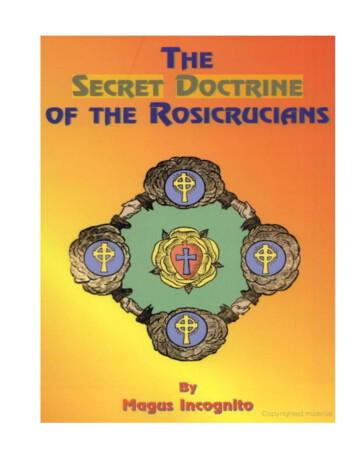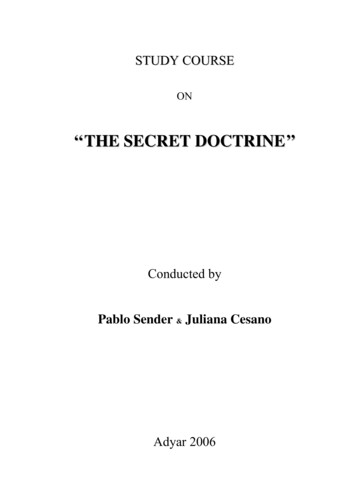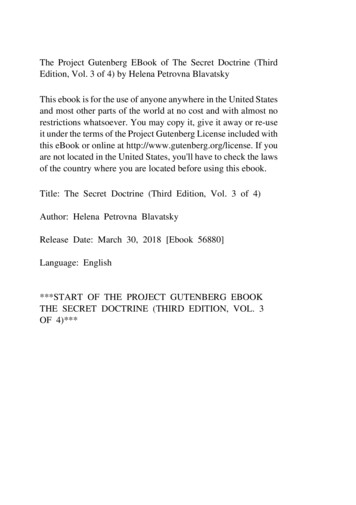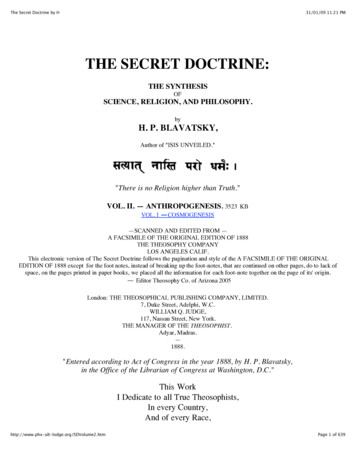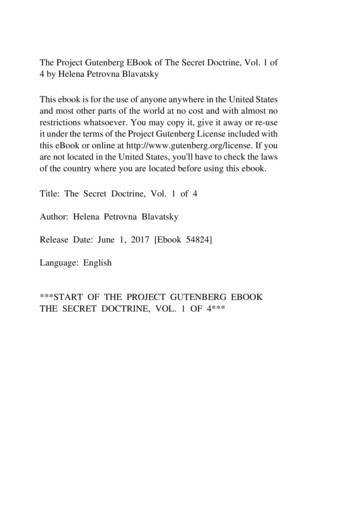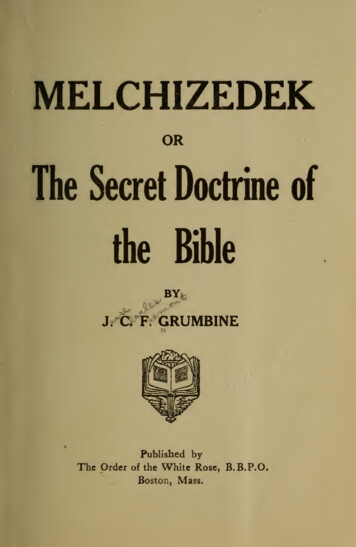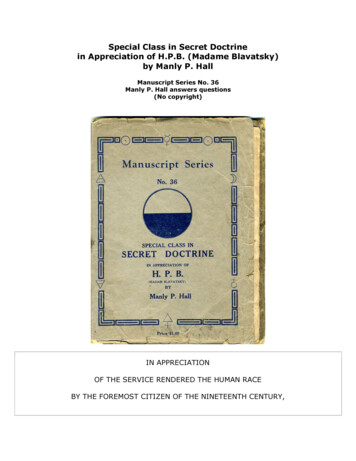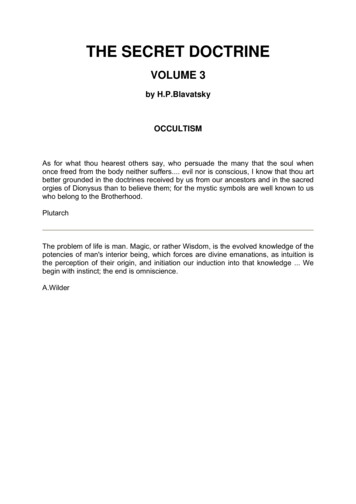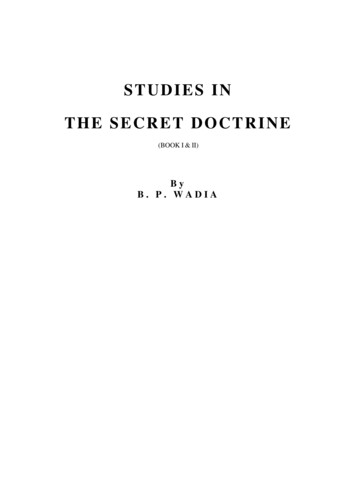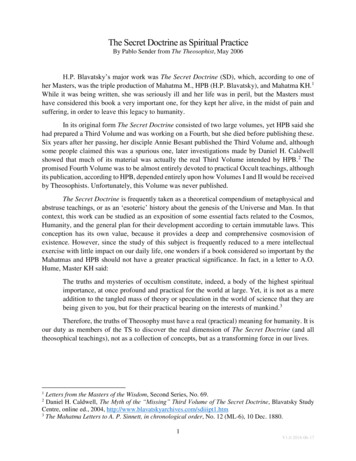
Transcription
The Secret Doctrine as Spiritual PracticeBy Pablo Sender from The Theosophist, May 2006H.P. Blavatsky’s major work was The Secret Doctrine (SD), which, according to one ofher Masters, was the triple production of Mahatma M., HPB (H.P. Blavatsky), and Mahatma KH.1While it was being written, she was seriously ill and her life was in peril, but the Masters musthave considered this book a very important one, for they kept her alive, in the midst of pain andsuffering, in order to leave this legacy to humanity.In its original form The Secret Doctrine consisted of two large volumes, yet HPB said shehad prepared a Third Volume and was working on a Fourth, but she died before publishing these.Six years after her passing, her disciple Annie Besant published the Third Volume and, althoughsome people claimed this was a spurious one, later investigations made by Daniel H. Caldwellshowed that much of its material was actually the real Third Volume intended by HPB. 2 Thepromised Fourth Volume was to be almost entirely devoted to practical Occult teachings, althoughits publication, according to HPB, depended entirely upon how Volumes I and II would be receivedby Theosophists. Unfortunately, this Volume was never published.The Secret Doctrine is frequently taken as a theoretical compendium of metaphysical andabstruse teachings, or as an ‘esoteric’ history about the genesis of the Universe and Man. In thatcontext, this work can be studied as an exposition of some essential facts related to the Cosmos,Humanity, and the general plan for their development according to certain immutable laws. Thisconception has its own value, because it provides a deep and comprehensive cosmovision ofexistence. However, since the study of this subject is frequently reduced to a mere intellectualexercise with little impact on our daily life, one wonders if a book considered so important by theMahatmas and HPB should not have a greater practical significance. In fact, in a letter to A.O.Hume, Master KH said:The truths and mysteries of occultism constitute, indeed, a body of the highest spiritualimportance, at once profound and practical for the world at large. Yet, it is not as a mereaddition to the tangled mass of theory or speculation in the world of science that they arebeing given to you, but for their practical bearing on the interests of mankind.3Therefore, the truths of Theosophy must have a real (practical) meaning for humanity. It isour duty as members of the TS to discover the real dimension of The Secret Doctrine (and alltheosophical teachings), not as a collection of concepts, but as a transforming force in our lives.1Letters from the Masters of the Wisdom, Second Series, No. 69.Daniel H. Caldwell, The Myth of the “Missing” Third Volume of The Secret Doctrine, Blavatsky StudyCentre, online ed., 2004, http://www.blavatskyarchives.com/sdiiipt1.htm3The Mahatma Letters to A. P. Sinnett, in chronological order, No. 12 (ML-6), 10 Dec. 1880.21V1.0 2018-06-17
“The Secret Doctrine” as Spiritual Practice by Pablo Sender from The Theosophist, May 2006Signposts on the PathAccording to HPB, The Secret Doctrine has different keys of interpretation: metaphysical,astronomical, physiological, psychological, and so forth. Therefore, we will attempt here toconsider these teachings from a psycho-metaphysical point of view, as HPB would say, lookingfor an interpretation that allows us to make them part of our spiritual practice.In a talk with some students, HPB is reported to have said:TRUTH lies beyond any ideas we can formulate or express.4and:No picture will ever represent the TRUTH’.5In another context, J. Krishnamurti also said:The unknown, the limitless, cannot be captured by thought.6Every authentic spiritual tradition or teaching states that Truth ‘is beyond the range and reach ofthought’. If this is so, how can the Truth be realized? Maybe the question arises because we areused to considering thought as our only tool, although according to Theosophical teachings, thisis not the case. HPB wrote:The INFINITE cannot be known to our reason, which can only distinguish and define; butwe can always conceive the abstract idea thereof, thanks to that faculty higher than ourreason — intuition, or the spiritual instinct.7The text is referring to buddhi, or Spiritual Intuition, which is the faculty we need toawaken for the perception of Truth. If the modern presentation of Theosophy has the object ofguiding us to this goal, it must provide us with tools to help us make operative this ‘power latentin man’ through which spiritual realities can be grasped.Thus, Mme. Blavatsky denied that the real value of The Secret Doctrine is to furnish acomplete philosophical account of existence, and advised:Come to the S.D. (she says) without any hope of getting the final Truth of existence fromit, or with any idea other than seeing how far it may lead TOWARDS the Truth. 8She said that this book is:A means of exercising and developing the mind never touched by other studies’,9 and theright work on it is ‘what the Indians call Jñāna Yoga.104How to Study Theosophy, Robert Bowen, (1997) TPH Adyar, p. 8.How to Study Theosophy, p. 13.6The Future of Humanity, First Conversation, Brockwood Park, 11 June 1983.7The Beacon of the Unknown, H. P. Blavatsky’s Collected Writings (CW), XI, p. 258.8How to Study Theosophy, p. 9.9How to Study Theosophy, p. 9.10How to Study Theosophy, p. 13.25V1.2 2018-08-16
“The Secret Doctrine” as Spiritual Practice by Pablo Sender from The Theosophist, May 2006Therefore, the information given in The Secret Doctrine is not an end in itself, but a means. As J.Krishnamurti said, ‘the word is not the thing’, and this book was written just ‘to provide him [thestudent] with sign posts on that Path’.11 When the student works rightly with The Secret Doctrine,it may lead him beyond the mental processes, where the light of Intuition may shine. This is whatHPB points out in the Proem when she wrote:Indeed, it must be remembered that all these Stanzas appeal to the inner faculties ratherthan to the ordinary comprehension of the physical brain. 12One important thing to bear in mind when engaged in theosophical study is the concept oflearning. In the present time, we tend to consider learning as the intake of new information fromoutside, and therefore we think we know Theosophy because we have collected concepts fromdifferent books and memorized them. But this knowledge mostly affects only the surface of ourbeing; therefore, there is a gap between theory and practice. The real learning, as Plato stated,comes from within, and the Stanzas try to awaken this inner knowledge, which may be what issometimes called ‘the archetypes in our deeper mind’. This knowledge is more comprehensive andhas a transformative effect upon us.1112How to Study Theosophy, p. 14.The Secret Doctrine (SD), I, 2003, TPH Adyar, 3-vol. ed., p. 21.3V1.2 2018-08-16
“The Secret Doctrine” as Spiritual Practice by Pablo Sender from The Theosophist, May 2006Awakening Spiritual PerceptionWe should be serious in examining what are the bases for awakening our spiritualperception. As we have said, the mere recollection of the information given in The Secret Doctrineis not enough, and we should not imagine that spiritual perception will be awakened in someobscure way simply by reading. To reach this ‘deeper mind’ is not so easy and there are severalfactors involved in it, as expressed in theosophical literature.HPB says that Intuition arises in ‘a state in which one ceases to be the conditioned andpersonal “I”, and becomes one with the ALL’.13 This is also the very core of J. Krishnamurti’steachings, since he was primarily interested in helping us transcend all activities of our brainconsciousness (kāma-manas). In one of his dialogues with Dr. David Bohm, he differentiatesbetween the Mind, which is universal and unconditioned, and the brain, which is limited. And hesays that the brain is the basis of the self, while the Mind is the source of the highest form ofintelligence. But then the question arises: how can that Mind act through the brain? According toJ. Krishnamurti, this is possible only when there is no sense of separateness:DB: You are using the word Mind; not ‘my’ Mind.JK: Mind. It is not ‘mine’.DB: It is universal or general.JK: Yes. . . .DB: It would almost seem to imply, then, that in so far as a person feels he is a separatebeing, he has very little contact with Mind.JK: Quite right. That is what we said.14So, both HPB and J. Krishnamurti established the necessity of leaving the ‘self’ behind as a basiccondition for awakening Intuition. Obviously, this breaking of that sense of separateness is notsomething that can be achieved taking a single course of action; all the different aspects of our lifehave to be orientated towards this aim, but here we will concentrate on how The Secret Doctrinecan help us in this task.1314The Beacon of the Unknown, CW, XI, p. 258.The Future of Humanity, Second Conversation, Brockwood Park, 20 June 1983, pp. 71-3.4V1.2 2018-08-16
“The Secret Doctrine” as Spiritual Practice by Pablo Sender from The Theosophist, May 2006First Fundamental PropositionThe Fundamental Propositions given in the Proem of The Secret Doctrine containstatements about the essential nature of the Cosmos and, at the same time, Mankind, which is amirror of the Universe. As HPB wrote:As above so it is below, as in heaven so on earth; and man — the microcosm and miniaturecopy of the macrocosm — is the living witness to this Universal Law and to the mode ofits action. 15Therefore, proper study of cosmic processes from an esoteric point of view can have adirect impact upon us in a variety of ways. We will attempt now to examine these FundamentalPropositions, not in full length or in all their connotations, but highlighting certain aspects usefulfor a psycho-metaphysical interpretation.The first one establishes that there is a ‘ground’ on which and through which the Cosmosis manifested. It is:An Omnipresent, Eternal, Boundless, and Immutable PRINCIPLE on which all speculationis impossible, since it transcends the power of human conception and could only bedwarfed by any human expression or similitude. It is beyond the range and reach of thought— in the words of Māṇḍūkya Upanishad, “unthinkable and unspeakable.” 16At first glance, it seems nonsensical to teach something on which all thinking or speculationis impossible; therefore, some say it is useless to study that Absolute Principle, even though it is aFundamental Proposition of Theosophical teachings. On the other hand, people who try to dealwith this subject frequently reduce it to a mere philosophical postulate about that primordial Unityin which illusory diversity takes place. But taking into account the fact that many pages in TheSecret Doctrine are dedicated to this Absolute Reality, there must be another reason for writingabout this ‘unthinkable and unspeakable’ Principle.This First Proposition and Stanza I in the first volume of The Secret Doctrine refer to theunmanifested state of the universe, where there is only infinite space and eternity in an absolutestate. According to HPB, right meditation (not merely intellectual study) upon this concept mayhave an important effect upon the mind. She recommended this exercise as the very foundation forpracticing her Diagram of Meditation, when she said: ‘First conceive of UNITY by expansion inSpace and infinite in Time.’ 17 This statement suggests that we expand the mind; but why? This isin order to abolish self-centeredness and lose the sense of time. As J. Krishnamurti repeatedlymentioned ‘the notion of time is based on thought’, and we find that in that state of universalityand eternity the mind becomes still and quiet, without images to work with. Later in her Diagram,HPB says that the normal state of our consciousness must be molded by: ‘Perpetual presence inimagination in all Space and Time.’ This could seem a mere fantasy, but the Diagram points outthat doing this will produce a change upon the consciousness:15SD, I, p. 274.SD, I, p. 14.17The Theosophist, May 2003, pp. 308-9.165V1.2 2018-08-16
“The Secret Doctrine” as Spiritual Practice by Pablo Sender from The Theosophist, May 2006From this originates a substratum of memory which does not cease in dreaming or waking.Its manifestation is courage. With memory of universality all dread vanishes during thedangers and trials of life.This last concept is quite evident because if we look inside ourselves, we will see that fearcomes from the sense of separateness, the identification of our consciousness with this mortal,small self, and this type of work helps us diffuse it. We find a similar statement in Light on thePath:Live neither in the present nor the future, but in the Eternal. This giant weed [of self] cannotflower there; this blot upon existence is wiped out by the very atmosphere of eternalthought. 18Then, establishing our consciousness in a state of universality and eternity (which is quitedifferent from talking about it) helps us to leave the self behind, and then there is the possibility ofbeing in rapport with the unconditioned. Let us consider it from another angle, as in the dialoguequoted above between J. Krishnamurti and Dr. Bohm:DB: What is the nature of the Mind? Is the Mind located inside the body, or is it in thebrain?JK: No, it is nothing to do with the body or the brain.DB: Has it to do with space or time?JK: Space — now wait a minute! It has to do with space and silence . . . .DB: Now I would like to go into the question of how they are making contact.JK: Ah! Contact can only exist between the Mind and the brain when the brain is quiet . .DB: And one can see that if the brain is quiet it could listen to something deeper?JK: That’s right. Then if it is quiet, it is related to the Mind. Then the Mind can functionthrough the brain.19Therefore, the correct meditation upon the First Fundamental Proposition, which points outa Reality beyond thought, may steer us to a condition of silence and quietude, where the self isnot, where Spiritual Intuition can arise.1819Light on the Path, 2000, TPH Adyar, p. 20.The Future of Humanity, Second Conversation, pp. 62, 67.6V1.2 2018-08-16
“The Secret Doctrine” as Spiritual Practice by Pablo Sender from The Theosophist, May 2006Second Fundamental PropositionHowever, we do not know how to proceed in that direction, being in the midst of a restlessmind. The Second Fundamental Proposition gives us a clue. It affirms:The Eternity of the Universe in toto as a boundless plane; periodically “the playground ofnumberless Universes incessantly manifesting and disappearing”.From a macrocosmic point of view, the Universe in toto (the Space) is eternal andboundless, but there is periodically an incessant movement of manifestation and dissolution takingplace within that immutable Space. The ‘numberless universes incessantly manifesting anddisappearing’ in the Macrocosms would correspond in the Microcosms with our feelings, thoughts,memories, and so on, which are constantly arising and coming to an end. Following the sequenceof these two Fundamental Propositions at first we must have, as far as possible, an ‘unconditioned’perception, and then deal with the conditioning within. This progression is closely related to theDiagram of Meditation mentioned above, where HPB says that after conceiving the Unity we haveto meditate on our states of consciousness. Why are we exhorted to do this? Perhaps this is astrategy to meditate ‘upon one’s lower self in the light of the inner divine man’20 and not as a mereintellectual analysis done by the conditioned mind. Here, we are looking at our normal movementfrom the highest state we are able to reach. This also resembles J. Krishnamurti’s answer to aquestion. When asked how we can build a bridge between our conditioned state and That which isunconditioned, he replied that it is impossible. The bridge has to be built from That to this. Ofcourse, this does not mean that we have to delude ourselves, taking for granted that the thinker isdifferent from the conditioning. The (lower) mind, the self, is the conditioning. But the (silent)faculty of perception is not inevitably limited to the brain consciousness, to the self. So, what isrequired here is for the perception to detach itself from the ego-sense and from identification withpsychological processes, which is done through that sense of ‘being the space’.To examine this more closely, each one experiences an incessant movement of sensations,feelings, thoughts, memories, expectations, and desires, in succession. Although nothing in thismovement is permanent, somehow, we attach to it a sense of being a single identity, ‘the thinker’,to whom all this occurs. But we do not realize that all these processes take place mechanically:there is ‘something’ in us that thinks or feels as a response to external or internal stimuli, or, inother words, those processes are merely the activity of skandha-s.21 However, identifyingourselves with that inner movement, we say ‘I am he who is thinking or feeling’. But thisperception is mistaken, because there is no thinker as a separate entity. If we observe silently, wemay realize there are only different thoughts, each one assuming the role of the ‘thinker’ whenactive, with memory connecting all the passing thoughts, thereby creating a sense of continuity.But then, what is permanent? As mentioned earlier, it is ‘the space’. This means that in the attemptto raise the consciousness from the impermanent to the Eternal, we have to identify ourselves withthe (inner) immutable space in which the psychological processes are taking place, that is, withthat which contains all movements, and not with the movement itself.2021SD, V, 1962, TPH Adyar, 6-vol. ed., p. 468; or CW, XII, p. 603.Psychic ‘aggregates’ of habits and tendencies.7V1.2 2018-08-16
“The Secret Doctrine” as Spiritual Practice by Pablo Sender from The Theosophist, May 2006As Śri Śaṃkarāchārya says:Space is not affected with the smell of wine by contact with the jar, and in the same wayone’s true nature is not affected through contact with the things one identifies oneselfwith.22One should become aware of oneself, indivisible and perfect like Space itself, when freefrom identification with such things as one’s body, senses, functions, mind, and sense ofdoership, which are all the products of one’s own ignorance. 23This suggestion is not an abstraction or imagination created by thought. When one isactually watching very quietly the inner movement and loses the sense of ‘me’, at least for the timebeing, there is a feeling of being just the space which embraces the psychological processes. Andthis state may be considered as one of pure ‘Self Existence’ because there is no sensation of ‘I amthis or that’, but one of pure ‘Be-ness’, simply a sense of identity without any demarcation.And there is something interesting in this process: we begin trying to put ourselves in theposition of being the Space, being the Witness of all that happens inside us, and finish in thatcondition of being the silent and quiet pure space. This resembles the famous statements of J.Krishnamurti: ‘The first step is the last step’, or ‘freedom (from the conditioning) has to be at thevery beginning’. In classical Theosophical literature we find similar concepts when it is said thatthe Path (the means) and the Goal are essentially one and the same.2223Viveka-chudāmani (The Crest-Jewel of Discrimination), v. 450.Viveka-chudāmani (The Crest-Jewel of Discrimination), v. 384.8V1.2 2018-08-16
“The Secret Doctrine” as Spiritual Practice by Pablo Sender from The Theosophist, May 2006Third Fundamental PropositionFinally, the Third Fundamental Proposition gives us a hint as to the correct attitude towardsdaily experiences. It establishes:The fundamental identity of all Souls with the Universal Over-Soul, the latter being itselfan aspect of the Unknown Root; and the obligatory pilgrimage for every Soul — a sparkof the former — through the Cycle of Incarnation, or ‘Necessity’, in accordance withCyclic and Karmic Law . . . [in order to] have an independent (conscious) existence.This Proposition affirms that we, as a consciousness, are essentially the Universal Oversoul, thatis, the Universal Mind. However, we have to live through these particular vehicles (the physical,emotional, and mental bodies) which limit that Universal Consciousness in order to acquire a pureself-conscious existence. Therefore, we cannot refuse to go through all experiences in life,irrespective of their being pleasant, painful, or neutral, and these experiences may not be of muchuse unless we go through them with a certain attitude. The Voice of the Silence says:The seeds of Wisdom cannot sprout and grow in airless space. To live and reap experiencethe mind needs breadth and depth and points to draw it towards the Diamond Soul. Seeknot those points in Māyā’s realm; but soar beyond illusions, search the eternal and thechangeless SAT [the one eternal and absolute Reality and Truth, all the rest being illusion],mistrusting fancy’s false suggestions.24Human beings change very slowly because, although we are alive, we are not experiencinglife to the fullest. We usually act mechanically, inattentively, and moreover, identify ourselveswith the personality, selecting pleasant experiences while rejecting those which are painful.Consequently, we learn very few lessons from them. But ‘to live and reap experience’ our mindneeds ‘breadth and depth’, that is, it needs to be open, vulnerable, void, not engaged in all thepsycho-physiological processes and reactions. It needs rather to be a Witness, and this is possibleonly if our consciousness is not confused with Māyā’s realm, ‘hearing fancy’s false suggestions’,but is pointed towards ‘the eternal and the changeless SAT’, the immutable Space or Be-ness, aspreviously discussed. In this way, the Fundamental Propositions can be seen as a spiritual practice,showing us what kind of attitude we should have while living our daily lives to really ‘reapexperience’.Those interested in this subject will find it useful to consult HPB’s Diagram of Meditation,which has further suggestions to complement this practice.The Theosophist, May 200624The Voice of the Silence, v. 114.9V1.2 2018-08-16
1 V1.0 2018-06-17 The Secret Doctrine as Spiritual Practice By Pablo Sender from The Theosophist, May 2006 H.P. Blavatsky’s major work was The Secret Doctrine (SD), which, according to one of her Masters, was the triple production of Mahatma M., HPB (H.P. Blavatsky), and Mahatma KH.1 While it was being writte
